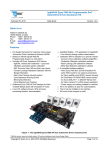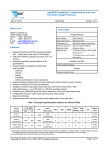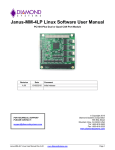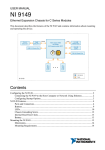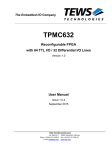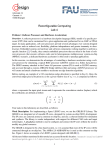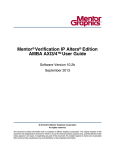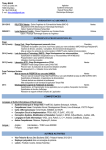Download logiSPI SPI to AXI4 Controller Bridge Xylon d.o.o. Features
Transcript
logiSPI SPI to AXI4 Controller Bridge rd September 3 , 2014 Data Sheet Version: v3.01 Core Facts Xylon d.o.o. Fallerovo setaliste 22 10000 Zagreb, Croatia Phone: +385 1 368 00 26 Fax: +385 1 365 51 67 E-mail: [email protected] www.logicbricks.com URL: Provided with Core Documentation User’s Manual Design File Formats Encrypted VHDL Constraints Files Verification Features Reference Designs & Contact Xylon Support for Application Notes information on Reference Designs Additional Items logiCRAFT-CC evaluation board • Supports Xilinx® Zynq®-7000 All Programmable SoC and all Xilinx FPGA families Simulation Tool Used • Bridge controller between the Serial Peripheral ModelTech’s Modelsim Interface (SPI) bus and the Advanced eXtensible Interface (AXI4) on-chip bus Support • Works as a Slave controller on the SPI bus, and a Support provided by Xylon master controller on the ARM® AMBA® AXI4 bus • Enables full-duplex communication (MSB first) between an external SPI Master controller and SoC/FPGA peripherals, on-chip and off-chip memories • Supports SPI telegrams of different lengths: single transfers or burst transfers (up to 2 kB, back-to-back) • Supports four signals interface (SI, SO, SCLK and SCS_N) • Provides transfer status signals, SPI telegrams acknowledgment and Slave reset mechanisms • Supports SCLK frequency of up to fclk/4, where fclk is frequency of the system clock (AXI4 clock) • Supports all SPI clock polarity (CPOL) and phase (CPHA) combinations • Prepared for Xilinx Vivado® and ISE® Design Suits Applications • Inter-chip board-level communications; i.e. external MCU controlling FPGA co-processor Table 1: Example Implementation Statistics for Xilinx® FPGAs Family Fmax (MHz) Fmax (MHz) (Device) M_AXI_ACLK clk 100 100 LCs Slices1 IOB2 BRAM 152 4 0 (FFs/LUTs) Spartan®-6 MULT/ DCM / DSP48/E CMT 0 0 Design GTx 278 1779 (XC6SLX45T-3) Artix -7 ISE 14.7 264 100 100 1690 (XC7A200T-3) ISE 152 4 0 0 0 N/A (428/703) Kintex™-7 14.7 278 100 100 1779 (XC7K70T-2) ISE 152 4 0 0 0 N/A (431/706) Zynq 14.7 243 100 100 1555 Vivado 156 (437/650) Tools N/A (435/729) ™ (XC7Z020-1) LUTRAM 4 0 0 0 N/A 2014.2 Notes: 1) Assuming 32-bit AXI4 master interface. 2) Assuming only SPI signals are routed off-chip; other signals are connected internally. Copyright © Xylon d.o.o. 2001-2014 All Rights Reserved Page 1 of 6 logiSPI – SPI to AXI4 Controller Bridge Data Sheet Version: v3.01 logiSPI SCS_N SCLK SO SPI Interface Module Read and Write Controller AXI4 Interface Module AXI4 bus SI Write_done Read_done SFRs Figure 1: logiSPI Architecture General Description The logiSPI SPI to AXI4 Controller Bridge IP core allows external host processors to communicate with peripherals or processors implemented in Xilinx Zynq-7000 All Programmable SoC and FPGAs through the Serial Peripheral Interface (SPI) serial bus. In enables easy implementations of Xilinx FPGA/SoC companion chips that expand the capabilities of the embedded host processor by adding missing host features and by offloading high-speed processing tasks. The IP core works as a SPI Slave bus controller and a 32-bit master controller on the AMBA Advanced eXtensible Interface (AXI4) on-chip bus. The SPI is a full-duplex synchronous and a four-wire serial interface between a single bus master, and one or more bus slave devices. The bus master initiates communication by asserting slave’s select signal and issuing a data frame (SPI telegram). Data is exchanged between the master and the selected slave device shift registers, which shift data bits synchronous on SPI clock signal generated by the master device. The logiSPI IP core accepts the SPI telegram sent by the SPI master, de-serializes it, decodes SPI Master’s commands and writes/reads data to/from Xilinx Zynq-7000 SoC or FPGA peripherals and on-chip memories interconnected with a high-speed 32-bit AXI4 on-chip bus. By mean of SoC/FPGA memory controllers, the logiSPI can relay large bursts of data (up to 2 kBytes) between the SPI master device and SDRAM-type memories connected to the Xilinx Zynq-7000 SoC or FPGA device. The logiSPI SPI to AXI4 Controller Bridge IP core implements an acknowledgment mechanism that assures integrity of data exchanged through the SPI bus. Properly decoded SPI telegrams are acknowledged by the command code bounced back to the SPI master, and the faulty telegrams are discarded. By asserting and deasserting the slave select signal, the SPI master can reset the logiSPI IP core’s operation. The following table shows SPI Master commands currently supported by the logiSPI IP core: Copyright © Xylon d.o.o. 2001-2014 All Rights Reserved Page 2 of 6 logiSPI – SPI to AXI4 Controller Bridge SPI Command RD_8 RD_16 RD_32 RD_SFR RD_BURST WR_8 WR_16 WR_32 WR_SFR WR_BURST Data Sheet Version: v3.01 Description Single transfer: 8-bit read Single transfer: 16-bit read. Single transfer: 32-bit read SFR access: read Special Function Register (internal logiSPI register) Burst transfer: read specified number of data bytes Single transfer: 8-bit write Single transfer: 16-bit write Single transfer: 32-bit write SFR access: write to Special Function Register (internal logiSPI register) Burst transfer: write specified number of data bytes Table 2: logiSPI supported SPI commands Functional Description The Figure 1 represents internal logiSPI architecture. The logiSPI functional blocks are: SPI Interface Module, Read and Write Controller, AXI4 Interface Module and SFRs Module. SPI Interface Module The logiSPI front-end part implements a state machine that receives SPI telegrams from a SPI master and controls shifting-in and shifting-out of serial data in a full-duplex mode. Serial data on the SPI bus is shifted MSB first. The SO (MISO) Serial Output is a tristate output to enable use in the SPI bus with multiple-slaves. Read and Write Controller Read and Write Controller checks incomming SPI telegram, de-codes the SPI command, and issues proper write or read operation to the SFRs Module or the AXI4 Interface module. 4 bits 12 bits variable (8, 16, 32 bits) SPI_CMD SPI_ADDR SPI_DATA Figure 2 SPI telegram structure for single transfers • • • SPI_CMD – SPI command (single transfer) SPI_ADDR – SPI address – 12 lowest bits of target AXI4 bus address (the upper address bits defined by the SFR register) SPI_DATA – SPI data bytes to write to/read from target system address 4 bits SPI_CMD 1 bit R 11 bits SPI_BURST_L 32 bits SPI_ADDR variable ((SPI_BURST_L + 1) x 8 bits) SPI_DATA Figure 3 SPI telegram structure for burst transfers • • • • • SPI_CMD SPI_ADDR SPI_DATA R SPI_BURST_L – – – – – WR_BURST/RD_BURST command (burst transfer) SPI address – complete 32-bit system address SPI data bytes to write to/read from target system address reserved burst length in number of bytes (0 – 2047) Copyright © Xylon d.o.o. 2001-2014 All Rights Reserved Page 3 of 6 logiSPI – SPI to AXI4 Controller Bridge Data Sheet Version: v3.01 AXI4 Interface Module The AXI4 Interface Module translates the decoded read and write commands from the Read and Write Controller into properly formatted AMBA AXI4 bus transfers, and vice versa, the AXI4 bus transfers into SPI formatted telegrams. The module contains write and read address/data FIFOs to compensate different data speeds on the parallel AXI4 bus and the serial SPI bus. SFRs SFRs Module contains Special Function Registers of the logiSPI IP core. Those registers are accessible only via SPI interface. Core Modifications The core is supplied in an encrypted VHDL format compatible with Xilinx Vivado IP Integrator and ISE Platform Studio. logiSPI has configuration parameters that are selectable prior to VHDL synthesis, and the following table presents a selection from a list of available parameters: Table 3: logiSPI VHDL Configuration Parameters Parameter Description C_SPI_MODE SPI communication mode selection (CPOL, CPHA) C_BURST_WIDTH Maximum number of AXI4 data transfers per burst If you wish to adopt the logiSPI IP core to your specific needs and/or supplement the features set, you can allow us to tailor the logiSPI to your requirements. Core I/O Signals The core signals I/O have not been fixed to any specific device pins to provide flexibility for interfacing with user logic. Descriptions of all I/O signals are provided in Table 3. Table 4: Core I/O Signals Signal Signal Description Direction Common signals clk Input System clock (AXI4 clock). System bus interface AXI4 Master Interface Bus Refer to ARM’s AMBA AXI4 protocol specification SPI signals sclk Input SPI serial clock scs_n Input SPI slave select si Input SPI serial input (MOSI) so_i Input SPI serial output (MISO) – input signal so_o Output SPI serial output (MISO) – output signal so_t Output SPI serial output (MISO) – three state control signal read_done Output Requested read data available on output port write_done Output Data successfully written to target system address Copyright © Xylon d.o.o. 2001-2014 All Rights Reserved Page 4 of 6 logiSPI – SPI to AXI4 Controller Bridge Data Sheet Version: v3.01 Verification Methods The logiSPI is fully supported by the Xilinx Vivado and ISE Design Suits. This tight integration tremendously shortens IP integration and verification. A full logiSPI implementation does not require any particular skills beyond general Xilinx tools knowledge. Recommended Design Experience The user should have experience in the following areas: - Xilinx design tools - ModelSim Available Support Products TM Xylon logicBRICKS IP cores can be evaluated on logiCRAFT-CC Xylon development platform, designed especially for developers working in the fields of multimedia and infotainment. This demonstrates modularity on all levels: software, board, FPGA, and IP cores. The platform makes development tool particularly appropriate for the development of embedded systems with strong capabilities. which is platform excellent graphics To learn more about the Xylon development platforms, contact Xylon or visit the web: Email: URL: [email protected] www.logicbricks.com Ordering Information This product is available directly from Xylon under the terms of the Xylon’s IP License. Please visit our web shop or contact Xylon for pricing and additional information: Email: URL: [email protected] www.logicbricks.com This publication has been carefully checked for accuracy. However, Xylon does not assume any responsibility for the contents or use of any product described herein. Xylon reserves the right to make any changes to product without further notice. Our customers should ensure that they take appropriate action so that their use of our products does not infringe upon any patents. Xylon products are not intended for use in the life support applications. Use of the Xylon products in such appliances is prohibited without written Xylon approval. Related Information Xilinx Programmable Logic For information on Xilinx programmable logic or development system software, contact your local Xilinx sales office, or: Xilinx, Inc. 2100 Logic Drive San Jose, CA 95124 Phone: +1 408-559-7778 Fax: +1 408-559-7114 www.xilinx.com URL: Copyright © Xylon d.o.o. 2001-2014 All Rights Reserved Page 5 of 6 logiSPI – SPI to AXI4 Controller Bridge Data Sheet Version: v3.01 Revision History Version Date 2.00. 18.04.2012. 3.01. 03.09.2014. Note Initial Xylon release. Update to AXI4. Support for Xilinx Vivado Design Suite. Copyright © Xylon d.o.o. 2001-2014 All Rights Reserved Page 6 of 6






